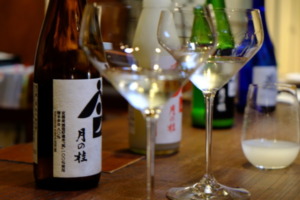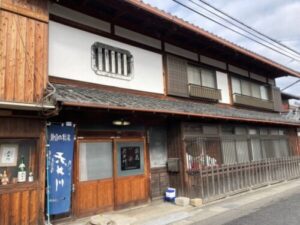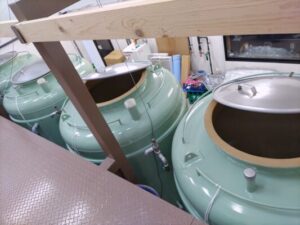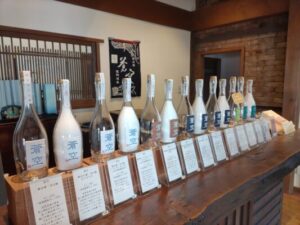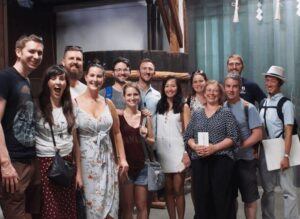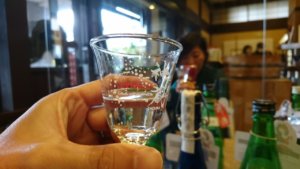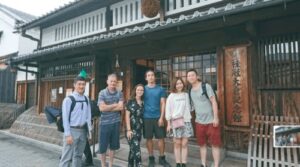Brewery Visit to Saito Shuzo
One of our team’s favourite brands, among those produced in Fushimi’s Sake District, is Eikun. This brand of sake has a completely different taste depending on its grade and kind.
We offer samplings of Eikun on our Kyoto Insider Sake Experience tour. Its fruity flavor is popular with tourists from all over the world. Saito Shuzo, located along the Takase River in Fushimi is the brewery which produces Eikun.
We had a chance to visit this brewery on 9th October, on the same day that this year’s new batch of sake had just been made available. Mr Nakamura, the manufacturing manager, gave us a behind-the-scenes tour of his brewery.
In the Brewery Saito Shuzo
The current sake brewmaster (or ‘toji’ in Japanese) at Saito Shuzo is Mr Urai. He belongs to an organization called Nanbu Toji, founded originally in Iwate prefecture. The brewmaster, or toji, is responsible for managing and directing the entire sake-making process. It requires abundant experience, knowledge and skill to become a toji.
They say that the quality of staff at Saito Shuzo is such that many of them have the same level of skill as the highest qualified ‘toji’. When we heard that, we came up with a simple question – when multiple superior people work together, how can things operate smoothly? However, at Saito Shuzo, it seems there is no problem in balancing the egos of excellent brewers. These highly skilled professionals work together with the joint aim of creating something great. It’s as simple as that. After hearing these stories we could easily see why the sake produced by this team has such an appeal.
Secret of Making Sake
Even in such an environment where human skill is undeniable, the use of machines is not disregarded. In the brewery, where machines are best placed to complete a step in the sake making process, they’re employed to do so. The brewer constantly checks and manages each of these processes – so the human touch is always there, to ensure the sake quality is never compromised.

During our visit, the chilling machine was cooling down the steamed rice.
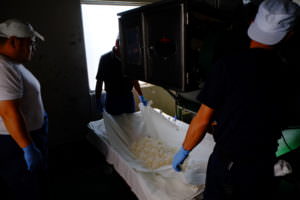
A brewer was constantly checking both the steamed rice and the cooled rice.
The steamed rice was made up of rice polished to 45%. It was shining like a jewel.
For the first time ever, we were able to try a sample of the steamed rice from this stage of the sake-making process. The rice was unexpectedly hard, and very different from typical cooked food rice. This steamed sake rice will become Kotosennen Junmai Daiginjo, which you can read about in our article “Top 4 Bottles you must try in Kyoto”.
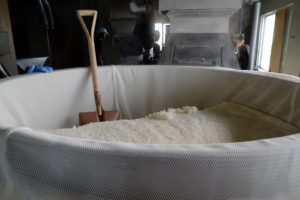
The steamed rice made up of rice polished to 45%
Sake Tasting
After our guided tour of the brewery was complete, they invited us to a sake tasting session. We tasted Junmai Daiginjo “Ichigin”, made using Yamada Nishiki sake rice, thought of as ‘the king of sake rice’. The rice has been polished to 35%, and the sake was ‘junmai nama genshu’, meaning it was unfiltered sake, with no added water or heat sterilization. On top of this, it was also a ‘junmai koshu’, or ‘aged sake’.

Bottles that they produce
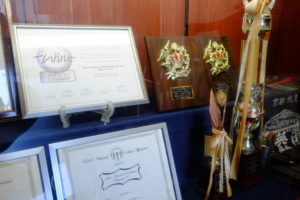
The brewery has won many prizes
After the tasting, we couldn’t help ourselves but buy a bottle of Junmai Namagenshu 24 H (a type of nama genshu which is bottled within 24 hours after squeezing) and Koto Sennen Junmai.
Saito Shuzo opens their brewery for visitors in March and October every year. This is a must-do for genuine fans of Japanese sake.
For those who can’t visit due to time restrictions, you can always try some of Saito Shuzo brewery’s sake by picking up a bottle when you’re in the area. Or, join us on a Kyoto Insider Sake Experience tour, where you’ll get to try and learn about a variety of sake and the secrets of the brewing process (including our beloved Eikun!) first-hand.
When visiting Kyoto, you can’t miss a sake tour of Fushimi – so why not join us on a hunt for the area’s best sake, and find your favourite along the way?
